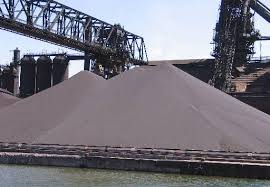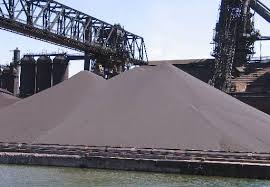
Things may be turning the corner for iron ore after the market for the steel-making commodity was is decline since 2011 amid an extended commodities crash.
It is however not certain how strong the recovery will be.
While China’s appetite for the commodity firms, the supply growth is unlikely to return to old highs anytime soon and this has pushed the world's biggest iron ore producers to maintain their output guidance for 2016.
Noting a rise in global steel production, which it said grew 6.1 percent on-quarter in Q2¸ Brazilian iron ore giant Vale gave an encouraging outlook in its second-quarter results announcement on Thursday. Growth in steel production in China alone was 9.2 percent in that period.
"Steel demand improved in China, supported by the credit easing started in 2H15. Investments in the housing sector increased while investments in infrastructure remained stable in 1H16. The higher steel demand boosted prices and encouraged worldwide production," Vale said.
On the back of seasonal factors, higher iron ore supply in the second half of the year is expected by the world's biggest producer.
While just slightly below the 89.3 million ton record it set in Q2 2015¸ Vale reported 86.8 million metric tons of production in the second quarter of 2016 last week.
Based on indicators like low steel inventories and a fall in the Chinese yuan against the dollar, its three - and six-month iron ore price forecast was raised by investment bank Goldman Sachs from $45 and $35 a ton to $50 and $40 a ton respectively and Vale's assessment came a after that announcement.
"The most important channel, in our view, is the market interpretation that CNY depreciation signals upcoming credit easing," wrote Goldman analysts.
Economic activities such construction and lending would be boosted by credit easing in China.
Spot iron ore prices hit all-time lows around $37 a ton in December and the improved market outlook is a turnaround from that period. Increased building activities in China, the world largest iron ore consumer had resulted in rallies of prices since then.
4.7 trillion yuan ($720 billion) would be invested on 303 transport infrastructure projects over three years, China had said in May this year.
Production this year was largely on track for Australian miners Rio Tinto and BHP Billiton according to their reports. While BHP said it missed its own iron ore guidance narrowly due to the Samarco dam disaster that shut down the Brazilian mine, Rio Tinto said last week that the company was on target to meet production guidance for the full-year 2016.
Forecasting output at the lower end of the 340-350 million ton range, Vale has maintained its 2016 output guidance.
However iron ore output growth has slowed despite the firm output forecasts.
As lower prices forced high-cost producers to shut, global iron ore production is expected to grow by just 0.1 percent from 3,149 million tons in 2016 to 3,275 million tons by 2020 according to BMI Research which said this in a note this week. These numbers would be 4.8 percent lower than the average growth rate between 2011 and 2015.
"On the one hand, supply growth will be primarily driven by Australia and Brazil on the back of expanding output by major miners, such as Rio Tinto, BHP Billiton, Vale and Fortescue Metals Group. On the other hand, miners in China, which operate on the higher end of the iron ore cost curve, will be forced to cut output due to continued iron ore price weakness,” the BMI analysts wrote.
(Source:www.cnbc.com)
It is however not certain how strong the recovery will be.
While China’s appetite for the commodity firms, the supply growth is unlikely to return to old highs anytime soon and this has pushed the world's biggest iron ore producers to maintain their output guidance for 2016.
Noting a rise in global steel production, which it said grew 6.1 percent on-quarter in Q2¸ Brazilian iron ore giant Vale gave an encouraging outlook in its second-quarter results announcement on Thursday. Growth in steel production in China alone was 9.2 percent in that period.
"Steel demand improved in China, supported by the credit easing started in 2H15. Investments in the housing sector increased while investments in infrastructure remained stable in 1H16. The higher steel demand boosted prices and encouraged worldwide production," Vale said.
On the back of seasonal factors, higher iron ore supply in the second half of the year is expected by the world's biggest producer.
While just slightly below the 89.3 million ton record it set in Q2 2015¸ Vale reported 86.8 million metric tons of production in the second quarter of 2016 last week.
Based on indicators like low steel inventories and a fall in the Chinese yuan against the dollar, its three - and six-month iron ore price forecast was raised by investment bank Goldman Sachs from $45 and $35 a ton to $50 and $40 a ton respectively and Vale's assessment came a after that announcement.
"The most important channel, in our view, is the market interpretation that CNY depreciation signals upcoming credit easing," wrote Goldman analysts.
Economic activities such construction and lending would be boosted by credit easing in China.
Spot iron ore prices hit all-time lows around $37 a ton in December and the improved market outlook is a turnaround from that period. Increased building activities in China, the world largest iron ore consumer had resulted in rallies of prices since then.
4.7 trillion yuan ($720 billion) would be invested on 303 transport infrastructure projects over three years, China had said in May this year.
Production this year was largely on track for Australian miners Rio Tinto and BHP Billiton according to their reports. While BHP said it missed its own iron ore guidance narrowly due to the Samarco dam disaster that shut down the Brazilian mine, Rio Tinto said last week that the company was on target to meet production guidance for the full-year 2016.
Forecasting output at the lower end of the 340-350 million ton range, Vale has maintained its 2016 output guidance.
However iron ore output growth has slowed despite the firm output forecasts.
As lower prices forced high-cost producers to shut, global iron ore production is expected to grow by just 0.1 percent from 3,149 million tons in 2016 to 3,275 million tons by 2020 according to BMI Research which said this in a note this week. These numbers would be 4.8 percent lower than the average growth rate between 2011 and 2015.
"On the one hand, supply growth will be primarily driven by Australia and Brazil on the back of expanding output by major miners, such as Rio Tinto, BHP Billiton, Vale and Fortescue Metals Group. On the other hand, miners in China, which operate on the higher end of the iron ore cost curve, will be forced to cut output due to continued iron ore price weakness,” the BMI analysts wrote.
(Source:www.cnbc.com)





